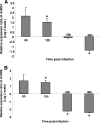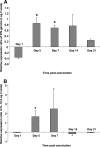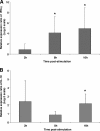Characterization of host responses against a recombinant fowlpox virus-vectored vaccine expressing the hemagglutinin antigen of an avian influenza virus
- PMID: 20071494
- PMCID: PMC2837961
- DOI: 10.1128/CVI.00487-09
Characterization of host responses against a recombinant fowlpox virus-vectored vaccine expressing the hemagglutinin antigen of an avian influenza virus
Abstract
There currently are commercial fowlpox virus (FPV)-vectored vaccines for use in chickens, including TROVAC-AIV H5, which expresses the hemagglutinin (HA) antigen of an avian influenza virus and can confer immunity against avian influenza in chickens. Despite the use of recombinant FPV (rFPV) for vaccine delivery, very little is known about the immune responses generated by these viruses in chickens. The present study was designed to investigate host responses to rFPV in vivo and in vitro. In cultured cells infected with TROVAC-AIV H5, there was an early increase in the expression of type I interferons (IFN), Toll-like receptors 3 and 7 (TLR3 and TLR7, respectively), TRIF, and MyD88, which was followed by a decrease in the expression of these genes at later time points. There also was an increase in the expression of interleukin-1beta (IL-1beta), IL-8, and beta-defensin genes at early time points postinfection. In chickens immunized with TROVAC-AIV H5, there was higher expression of IFN-gamma and IL-10 at day 5 postvaccination in spleen of vaccinated birds than in that of control birds. We further investigated the ability of the vaccine to induce immune responses against the HA antigen and discovered that there was a cell-mediated response elicited in vaccinated chickens against this antigen. The findings of this study demonstrate that FPV-vectored vaccines can elicit a repertoire of responses marked by the early expression of TLRs, type I interferons, and proinflammatory cytokines, as well as cytokines associated with adaptive immune responses. This study provides a platform for designing future generations of rFPV-vectored vaccines.
Figures






Similar articles
-
Development and use of fowlpox vectored vaccines for avian influenza.Ann N Y Acad Sci. 2006 Oct;1081:193-201. doi: 10.1196/annals.1373.023. Ann N Y Acad Sci. 2006. PMID: 17135511 Review.
-
Protection of chickens against highly lethal H5N1 and H7N1 avian influenza viruses with a recombinant fowlpox virus co-expressing H5 haemagglutinin and N1 neuraminidase genes.Avian Pathol. 2003 Feb;32(1):25-32. doi: 10.1080/0307945021000070688. Avian Pathol. 2003. PMID: 12745375 Clinical Trial.
-
The immune response of a recombinant fowlpox virus coexpressing the HA gene of the H5N1 highly pathogenic avian influenza virus and chicken interleukin 6 gene in ducks.Vaccine. 2012 Sep 28;30(44):6279-86. doi: 10.1016/j.vaccine.2012.08.008. Epub 2012 Aug 15. Vaccine. 2012. PMID: 22902682
-
Immune responses of chickens inoculated with a recombinant fowlpox vaccine coexpressing HA of H9N2 avain influenza virus and chicken IL-18.Antiviral Res. 2011 Jul;91(1):50-6. doi: 10.1016/j.antiviral.2011.04.007. Epub 2011 Apr 23. Antiviral Res. 2011. PMID: 21549153
-
Innovation in Newcastle Disease Virus Vectored Avian Influenza Vaccines.Viruses. 2019 Mar 26;11(3):300. doi: 10.3390/v11030300. Viruses. 2019. PMID: 30917500 Free PMC article. Review.
Cited by
-
Infection of Goose with Genotype VIId Newcastle Disease Virus of Goose Origin Elicits Strong Immune Responses at Early Stage.Front Microbiol. 2016 Oct 4;7:1587. doi: 10.3389/fmicb.2016.01587. eCollection 2016. Front Microbiol. 2016. PMID: 27757109 Free PMC article.
-
Integrated host and viral transcriptome analyses reveal pathology and inflammatory response mechanisms to ALV-J injection in SPF chickens.Sci Rep. 2017 Apr 12;7:46156. doi: 10.1038/srep46156. Sci Rep. 2017. PMID: 28401895 Free PMC article.
-
A Marek's Disease Virus Messenger RNA-Based Vaccine Modulates Local and Systemic Immune Responses in Chickens.Viruses. 2024 Jul 18;16(7):1156. doi: 10.3390/v16071156. Viruses. 2024. PMID: 39066318 Free PMC article.
-
Viral vector-based influenza vaccines.Hum Vaccin Immunother. 2016 Nov;12(11):2881-2901. doi: 10.1080/21645515.2016.1210729. Epub 2016 Jul 25. Hum Vaccin Immunother. 2016. PMID: 27455345 Free PMC article.
-
Design and evaluation of the immunogenicity and efficacy of a biomimetic particulate formulation of viral antigens.Sci Rep. 2017 Oct 23;7(1):13743. doi: 10.1038/s41598-017-13915-x. Sci Rep. 2017. PMID: 29062078 Free PMC article.
References
-
- Abdul-Careem, M. F., B. D. Hunter, L. F. Lee, J. H. Fairbrother, H. R. Haghighi, L. Read, P. Parvizi, M. Heidari, and S. Sharif. 2008. Host responses in the bursa of Fabricius of chickens infected with virulent Marek's disease virus. Virology 379:256-265. - PubMed
-
- Abdul-Careem, M. F., B. D. Hunter, P. Parvizi, H. R. Haghighi, N. Thanthrige-Don, and S. Sharif. 2007. Cytokine gene expression patterns associated with immunization against Marek's disease in chickens. Vaccine 25:424-432. - PubMed
-
- Abdul-Careem, M. F., B. D. Hunter, A. J. Sarson, A. Mayameei, H. Zhou, and S. Sharif. 2006. Marek's disease virus-induced transient paralysis is associated with cytokine gene expression in the nervous system. Viral Immunol. 19:167-176. - PubMed
-
- Abdul-Careem, M. F., D. B. Hunter, M. D. Lambourne, L. R. Read, P. Parvizi, and S. Sharif. 2008. Expression of cytokine genes following pre- and post-hatch immunization of chickens with herpesvirus of turkeys. Vaccine 26:2369-2377. - PubMed
Publication types
MeSH terms
Substances
LinkOut - more resources
Full Text Sources
Other Literature Sources

